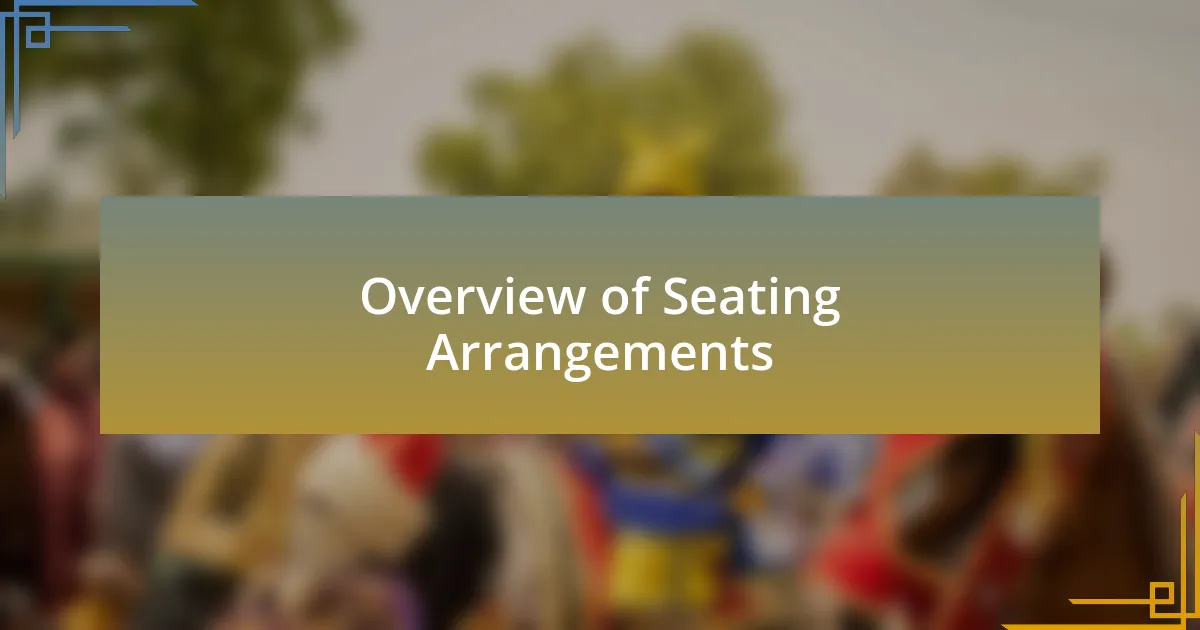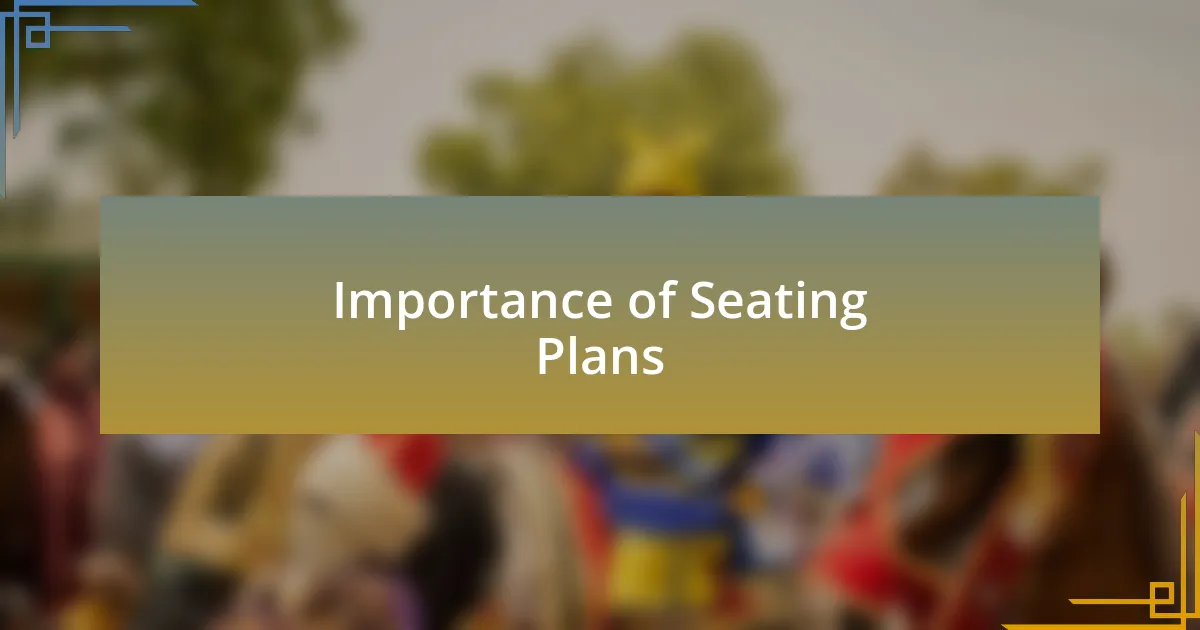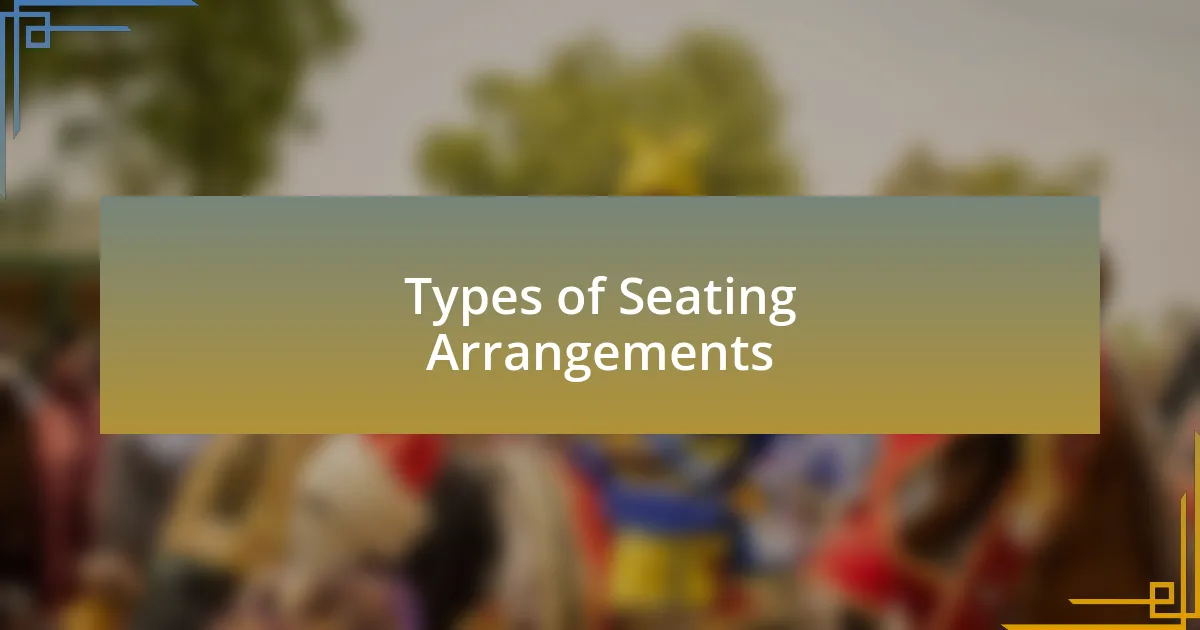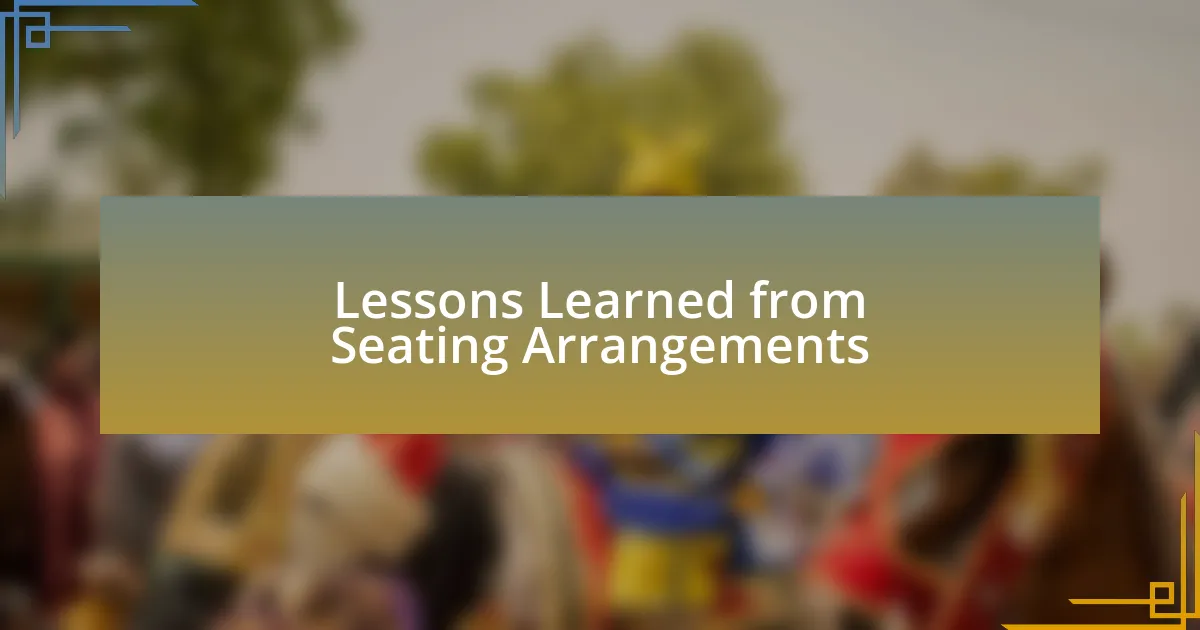Key takeaways:
- Seating arrangements significantly shape the wedding atmosphere and social dynamics, influencing guest interactions and overall enjoyment.
- Different seating styles—such as circular, banquet, or lounge—can enhance inclusivity and create a more relaxed environment for guests.
- Careful planning of seating can mitigate family tensions and foster connections between guests, enhancing the celebration experience.
- Personal touches and thematic arrangements can make seating visually appealing and meaningful, creating lasting memories for attendees.

Overview of Seating Arrangements
Seating arrangements at weddings play a crucial role in shaping the overall atmosphere of the event. Imagine stepping into a beautifully decorated venue, where each table is thoughtfully placed not just for aesthetics but to encourage meaningful conversation. I once attended a wedding where my seat ended up next to someone I hadn’t seen in years, sparking an unexpected reconnection. Isn’t it fascinating how a simple decision about where to sit can lead to heartfelt moments?
When planning seating, it’s important to consider not just family dynamics but also friendships and individual personalities. I remember helping a friend arrange her seating chart and realizing how pivotal it was in crafting a welcoming environment. She carefully grouped guests who shared common interests, which made the evening flow effortlessly. Have you ever thought about how your seating choices can influence the energy of the celebration?
Different styles of seating arrangements—traditional, circular, or even lounge setups—can dramatically change the vibe of your wedding. I find that a circular arrangement encourages inclusivity, making everyone feel more connected. Reflecting on my experiences, I believe that every couple should consider what fits their style and guests best, as the right arrangement can elevate the experience for everyone involved. What would you choose?

Importance of Seating Plans
When it comes to weddings, the right seating plan can be the backbone of a successful event. I recall a wedding where the couple placed their closest friends together at one table, igniting laughter and camaraderie that filled the room. It’s amazing how a well-thought-out seating arrangement can create such an inviting atmosphere.
The importance of seating plans goes beyond mere logistics; they can help guide the social dynamics of the day. I once witnessed a situation where guests who were unfamiliar with each other were seated together, which led to some awkward moments and a noticeable disconnect. Reflecting on it, I realized that thoughtful placements can encourage connections and dialogue, making the celebration enjoyable for everyone. Have you thought about how your choices might impact your guests?
Moreover, seating plans can also aid in managing family dynamics. At one wedding I attended, the bride made sure to seat her estranged relatives at opposite ends of the room, preventing any potential conflicts from arising. This experience drove home the idea that careful planning not only enhances enjoyment but also ensures a smooth celebration free from tensions. Wouldn’t it be worth it to invest time in crafting a seating plan that promotes harmony?

Types of Seating Arrangements
When considering seating arrangements, the traditional round table setup often comes to mind. It promotes inclusivity, allowing guests to engage with one another easily. I remember a reception where the round tables not only facilitated interaction but also encouraged guests to spill laughter and stories over shared meals, creating lasting memories throughout the evening.
Another popular option is the long banquet table arrangement. This style creates a communal feel, perfect for larger gatherings. I attended a charming wedding where the couple chose this layout, and the sense of togetherness was palpable, as guests felt more like part of a family gathering than a formal event. Have you considered how the layout can influence the atmosphere?
Lastly, I find intimate lounge seating to be a delightful twist for cocktail receptions. Cozy arrangements with sofas and armchairs invite conversation and relaxation. At one such event, I noticed how this setup allowed guests to unwind and connect more organically, as they felt less like guests at a formal affair and more like friends at a cozy gathering. Wouldn’t you want your guests to enjoy such a welcoming environment?

Factors Influencing Seating Choices
Seating choices can significantly impact the dynamics of your event, influenced by factors like guest relationships and the overall theme. I remember once helping a couple decide their arrangement based on their families’ relationships; they opted to separate a few contentious relatives, which allowed for a more harmonious atmosphere. Have you thought about how family dynamics might play into your seating plan?
The size of the venue also plays a crucial role. I once attended a wedding in a beautiful but compact space where the couple had to be clever with their arrangements to maximize both comfort and intimacy. It struck me how effective planning is essential to ensure that guests aren’t cramped while still encouraging interaction. Isn’t it fascinating how the layout can transform a place?
Additionally, the formality of the event shouldn’t be overlooked. A majestic ballroom calls for a more structured layout, while a beach wedding offers the freedom of a relaxed style. I’ve seen couples who embraced this coastal vibe with picnic-style seating on blankets, which created a friendly and carefree environment. How do you envision your ideal wedding atmosphere?

Tips for Effective Seating Arrangements
When planning your seating arrangements, think about the flow of conversation among your guests. I once helped a friend arrange her wedding seating and noticed how grouping friends with similar interests sparked lively discussions. It really highlighted the importance of considering commonalities among guests; would you prefer your old college buddies mingling with family, or would that create an awkward silence?
Also, don’t forget to account for the comfort of your guests. At a wedding I attended, the couple placed elderly relatives near the front, ensuring they had a great view without having to navigate the crowd. It made all the difference! Have you considered how comfort can greatly enhance your guests’ experience?
Finally, make it visually appealing. I’ve seen couples use decorative name cards that matched their theme, turning an ordinary arrangement into a stunning focal point. It’s astonishing how these little touches can elevate the entire event. Have you thought about how you can add your personal flair to the seating layout?

Personal Experience with Seating Plans
One of my most memorable experiences with seating plans came during my sister’s wedding. She wanted to create an intimate atmosphere, so we decided to arrange tables in a circular format. This choice encouraged mingling and made it easy for guests to share moments, sparking conversations that flowed naturally throughout the evening. Have you ever noticed how the layout can change the energy in the room?
I remember helping a couple who were torn between traditional seating and a more relaxed, open layout. They eventually chose the latter, and the results were incredible. Guests felt more at ease, bonding over shared laughter without the rigid confines of assigned chairs. What a difference it made when comfort was prioritized over convention!
An unexpected lesson I learned was about balancing family dynamics. I placed my quirky uncle and serious aunt at opposite ends of the table, fearing for conversational disasters. To my surprise, they ended up sparking a debate that entertained everyone! It was a beautiful reminder that sometimes, a little risk in your seating arrangement can create unforgettable memories.

Lessons Learned from Seating Arrangements
When arranging seats, I quickly learned the value of considering guest relationships. At a close friend’s wedding, we paired old friends from college with relatives they had never met. The result? A delightful evening filled with laughter and shared memories, transforming strangers into new friends. Have you ever thought about how mixing different social circles can lighten the mood and spark connections?
An essential lesson that stands out to me involves the importance of flexibility. I once helped a couple who initially had a rigid seating chart, but when a few guests called in sick last minute, we had to adapt. Instead of panicking, we embraced the change and reshuffled the tables. This spontaneous rearrangement fostered a relaxed vibe that allowed the remaining guests to engage more freely, reinforcing that a little flexibility can lead to unexpected joy.
I’ve also discovered the power of thematic seating. At a wedding where love for travel inspired the decor, we set tables based on different countries. Guests felt a sense of belonging as they shared traditions and stories related to their assigned theme. This creative approach not only ignited memorable conversations but also helped guests find common ground, proving that a well-thought-out seating plan can create a shared experience that resonates long after the day ends.